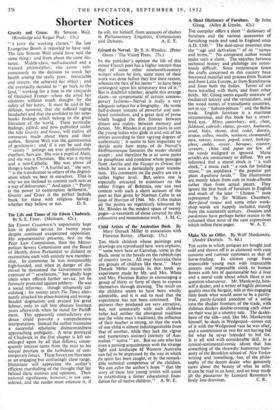THE compiler offers a short " dictionary of furniture and
the various accessories of furnishing made and used in England since A.D. 1100." The dust-cover promises also the " age and derivation " of its " names and terms." No competent author would make such a claim. The marches between technical history and philology are notor- iously difficult. Since romanesque times the crafts concerned in this country have borrowed material and process from Teuton and from Latin Europe, as from Scandinavia and from both the Indies. Terms of art have travelled with them, and from other fields. Mr. Gloag seems equally unaware of mediaeval latinity and the vernaculars, and the wood names of transatlantic countries, not to say "hobson-jobson " and the Baltic trade. English furniture is a maritime circumstance, and this book has a street- bred eye. Mitre, canterbury, ark, chair, faldstool, cabriole, chaise, go-cart, huaiacan, stool, bidet, throne, deal, cedar, danske, acajau, calico, muslin, wainscot, coromandel, turn, mirror, veneer, pagod, court, looking- glass, caddy, oyster, baroque, counter, scrutore, china and japan are few of the words maligned or ignored. Many articles are unnecessary or diffuse. We are informed that a mural clock is " a wall clock," a music rack " a rack for holding music," an aspidistra " the popular pot plant Aspidistra !arida." The illustrations are mostly taken from cuts in trade-albums rather than from actual pieces. They ignore the first book of furniture in English and much of the later " Chinese " taste represented by Sir William Chambers. Bare faced tongue and some other work- shop words are happily included, mostly from the nineteenth century. Omnium and purdonium have perhaps better reason to be exhumed than most of the cant expressions which inflate these pages. W. A. T.


































 Previous page
Previous page